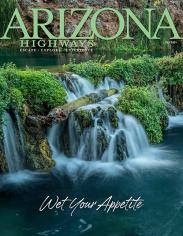Tucked away in the shadow of the rugged Bradshaw Mountains, not far from Lake Pleasant, Castle Hot Springs once boasted a dazzling guest list — from Rockefellers to Carnegies to a Kennedy. Yet for 40 years, the resort sat empty, frequented only by a caretaker and countless owners whose grand plans for the site fizzled.
The Spenazuma Swindle
Arizona history is full of swindlers, but few were as brazen as Richard C. Flower, who advertised his con right in the name of the operation. As the story goes, in the late 1890s, Flower was seeking to incorporate his mining company and was asked what he wanted to name it. He replied, “Any name that will cause them to spend their mazuma” (a Yiddish-derived slang term for money). And Spenazuma was born.
